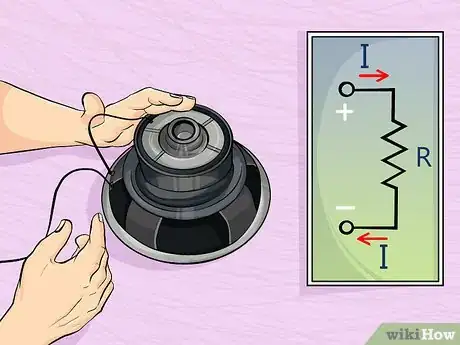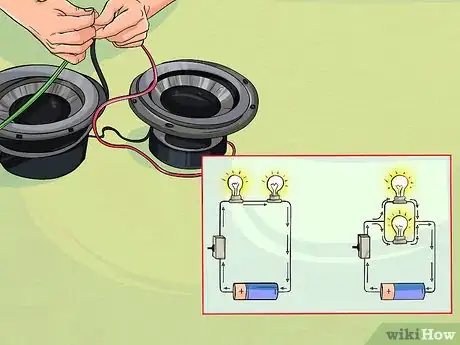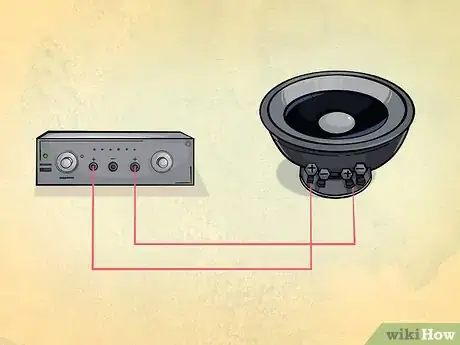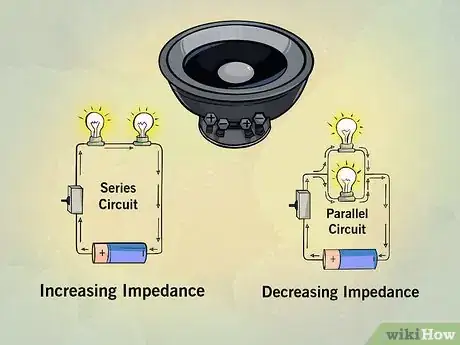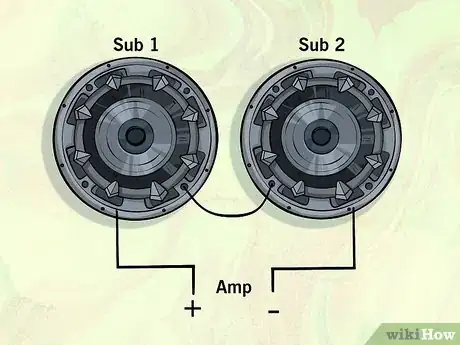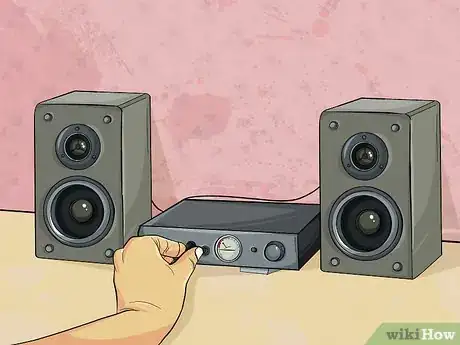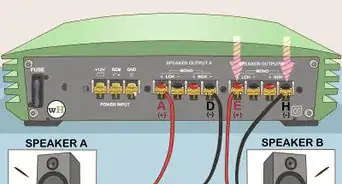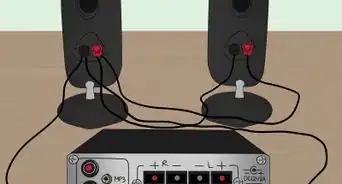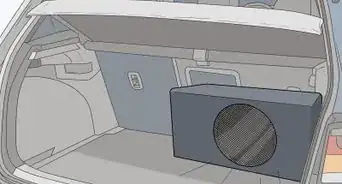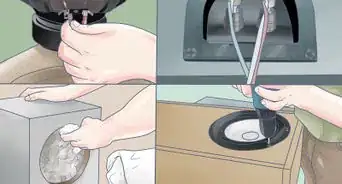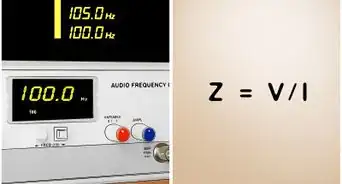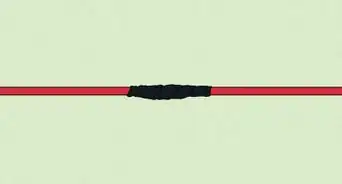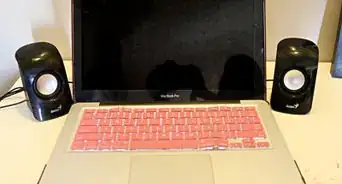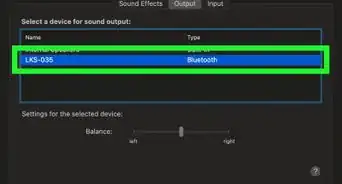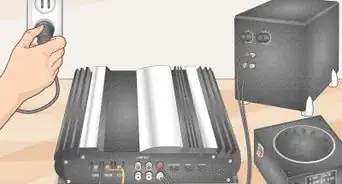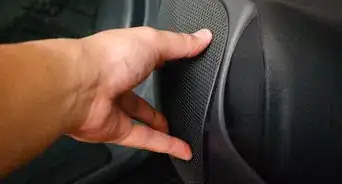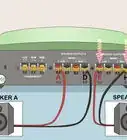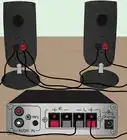This article was co-authored by wikiHow Staff. Our trained team of editors and researchers validate articles for accuracy and comprehensiveness. wikiHow's Content Management Team carefully monitors the work from our editorial staff to ensure that each article is backed by trusted research and meets our high quality standards.
This article has been viewed 256,329 times.
Learn more...
The term "bridging sub-woofers" is a bit misleading. The phrase actually refers to wiring the sub-woofers up to a bridged amplifier to produce fuller, deeper bass. This generally leads to a superior sonic experience coming from your home or car stereo system. Learning the ins and outs of a bridged circuit is important, though, as an improper setup can damage your equipment.
Steps
Preparing to Wire Your Subs to a Bridged Amp
-
1Locate the specification labels for your system. Your amp should have a label near the speaker output jack that indicates the output power (measured in Watts) and the minimum impedance (measured in Ohms). Be sure that your use the values for bridged mode, it is usually double the minimum impedance as stereo mode (meaning you need a much high impedance to run a bridged system) and up to four times the power output. Your sub-woofers should also be labeled with an impedance value (in Ohms) and a value indicating the maximum power input that they can handle (in Watts).[1]
- The majority of amps on the home theater market are only stable at 4 ohms when bridged. Most car stereo amplifiers can do 2 ohms.
-
2Write down these values. You should have at least four different values written down.
- Amp Bridged Output Power
- Amp Bridged Minimum Impedance
- Speaker Power Rating
- Speaker Impedance
Advertisement -
3Calculate the total impedance of all of your speakers. To do this you should add together the speaker impedance number for all of your speakers. You want the impedance to be at least equal to the minimum impedance value of your amp on each channel, but not to exceed 16 Ohms unless your amp is specifically rated for impedance values above 16 Ohms.[2]
- The formula for finding total impedance for speakers wired in series is Z1 + Z2 + Z3 …. = Ztotal. Where Z is the impedance of a given speaker.
- For example, if you have three speakers with impedance values of 4 Ohms, 6 Ohms, and 8 Ohms your total impedance wired in series would be 18 Ohms (4+6+8=18).
- The formula for finding total impedance of speakers wired in parallel is a little trickier. It is (Z1 x Z2 x Z3…) / (Z1 + Z2 + Z3…) =Ztotal.
- So say you have two speakers with impedances of 6 Ohms and 8 Ohms. This time it would look like this: 1) Multiply the values. 6 x 8 = 48 Ohms 2) Add the values. 6 + 8 = 14 Ohms 3) Divide the top by the bottom to find your total impedance. 48/14 = 3.43 Ohms (rounded)
- You can also use an impedance calculator such as this one http://www.speakerimpedance.co.uk/.
-
4Calculate the power each speaker will receive. This will be based upon the total impedance and the power output of your amplifier. You can use variations of Ohm’s Law to do the calculations yourself[3] or you can refer to the online calculator above. You do not want to overpower and blow your speakers.
-
5Verify that your amp has enough power for your subs. The output power should be stamped near the output jack on your amplifier and measured in Watts. You speakers should also be labeled with a wattage. The output wattage should meet or exceed the sum of all of your speakers. For example if you have two subs that each pull 200 W, you would want an amp that produces a minimum of 400 W. Ideally you would have an amp that produces more than what is required, this is referred to as "head room" and helps to avoid clipping.
-
6Unplug your equipment. Wiring powered devices can be dangerous. If you are working on a car stereo system you can simply disconnect the battery terminals.
Wiring Single Voice Coil Subs to a Bridged Amp
-
1Get a roll of stereo wire. You will need this wire to make the connections from your amplifier to your sub-woofers.[4]
- 12- to 16 gauge speaker wire is recommended for use with subwoofers.
- See How to Wire Speakers for tips on connecting speaker wires.
-
2Wire the amplifier to the subwoofers. Check to see which two terminals are used for bridge mode on your amplifier. This will be labeled on the amp. Wire the first sub by running a wire from the positive terminal on the amp to the positive bridge terminal on the sub.
-
3Wire the second subwoofer to the first subwoofer. If you wish to wire them in series, run a single wire from the negative terminal of the first sub to the positive terminal of the second sub. If you wish to wire them in parallel you will run two wires between the two subs. The firs will connect the two positive terminals, and the second will connect the two negative terminals.
-
4Complete the circuit. Connect the wire from the second sub's negative terminal to the negative bridge terminal on the amp. This will complete the circuit whether you are wiring in parallel or in series.
Wiring Dual Voice Coil Subs to a Bridged Amp
-
1Wire the amplifier to the first subwoofer. The wiring here will be similar to wiring a single voice coil (SVC) sub-woofer. The difference to remember is that dual voice coil (DVC) subs have two coils, and thus four input terminals. Two of them are positive and two are negative. Choose one of the positive terminals and connect it to the positive bridged terminal of the amp.
-
2Connect the two coils. Just like wiring two separate speakers, the two coils within your DVC can be wired in series (increasing the sub's impedance) or in parallel (decreasing the sub's impedance).
- If you are wiring the coils in series then run a wire from the positive terminal of the first coil (the one wired to the amp) to the negative terminal of the second coil and from the negative terminal of the first coil to the positive terminal of the second.
- If you are wiring the coils in parallel then run a wire from the first positive terminal to the second positive terminal and a wire from the first negative terminal to the second negative terminal.
-
3Wire the second subwoofer to the first subwoofer. Again, you have the series verses parallel debate.
- If you choose to wire the subs in series, connect the negative end of the second coil in the first sub to the positive end of the first coil in the second sub (these circuits can get complicated fast). Next, connect the negative end of the first coil to the positive end of the second coil. Finally connect the negative end of the second coil to the negative bridged terminal on the amp.
- If wiring in parallel, connect the negative end of the first sub's second coil to the negative end of the second sub's second coil. Connect the positive end of the first sub's first coil to the positive end of the second sub's first coil.
-
4Connect the second sub's coils. Follow the same guidelines as when you connected the first sub's coils.
-
5Complete the circuit. Now comes the easy part. Regardless of which combinations of series and parallels you chose above to get the proper impedance and power distribution in your system, closing the circuit will be one easy step. Run a wire to connect the negative terminal of the second coil in your second sub to the negative bridged terminal of the amp.
-
6Listen for inconsistencies. Power up your system and test it out. Start at a low volume and then slowly increase it to listen for anything that doesn’t sound right, like static or a difference in volume between the two subwoofers. If the bass and sub-bass are quiet or not present at all, something is mis-wired.
Community Q&A
-
QuestionHow do I stop a new stereo amp from locking on protection mode with the first hard hit on bass?
 Community AnswerMake sure you read the manual, and if that doesn't work, then contact the company from where you got that stereo.
Community AnswerMake sure you read the manual, and if that doesn't work, then contact the company from where you got that stereo. -
QuestionHow do I bridge a 4 channel amp with 2 SVC subs and use all 4 channels?
 Community AnswerUse the positive from channel 1 and the negative from channel 2 to one of your subs. Then use the positive from channel 3 and the negative from channel 4 to your other sub.
Community AnswerUse the positive from channel 1 and the negative from channel 2 to one of your subs. Then use the positive from channel 3 and the negative from channel 4 to your other sub. -
QuestionHow do I bridge a woofer when I have one single voice coil and one double voice coil?
 Community AnswerIt depends on the amplifier. If it is capable of driving (powering) low impedance loads, then it can be done. If you end up putting the subs in series, then you won't get much volume out of the system. Attach + to + and - to - on the dual voice coil, then + to + amp on the single, - (single) to + (double), then - (double) to - amp. If the dual VC was 2x 4 ohm, that would give 2 ohm; if the SV is 4 ohm, you add the 2 to get 6 ohm.
Community AnswerIt depends on the amplifier. If it is capable of driving (powering) low impedance loads, then it can be done. If you end up putting the subs in series, then you won't get much volume out of the system. Attach + to + and - to - on the dual voice coil, then + to + amp on the single, - (single) to + (double), then - (double) to - amp. If the dual VC was 2x 4 ohm, that would give 2 ohm; if the SV is 4 ohm, you add the 2 to get 6 ohm.
Warnings
- Use caution when wiring any electrical devices.⧼thumbs_response⧽
Things You'll Need
- 2 subwoofers
- Mono amplifier
- Stereo wire (12-16 gauge recommended)
